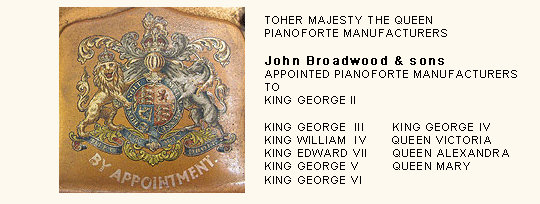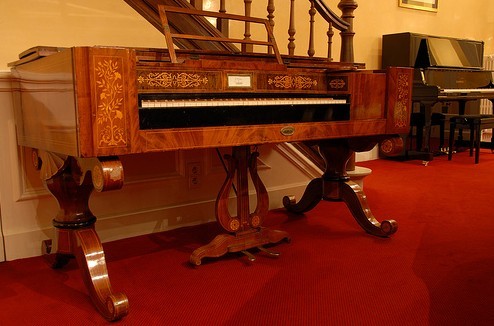|
制造商介绍

布罗德伍德—世界最富盛名的钢琴品牌
约翰·布罗德伍德(John Broadwood)的观念对现代钢琴的音色、外观、演奏机制都产生了巨大的影响。聚集在他周围的是诸多著名的音乐家和这一行业的大师们。他在这一领域的革新,证明他的贡献具有永恒的价值。
约翰·布罗德伍德1732年生于苏格兰,早先学习家具制作。1761年他迁居伦敦,为拨弦古钢琴制作师伯卡特·舒第(Burkat Shudi)工作。1770年他娶了舒第的女儿,一年以后,他的岳父将伦敦大普尔特尼(Great Pulteney)街上的工厂交给他打理。莫扎特曾经在他的工厂弹奏过,而伯卡特·舒第的好友亨德尔在这里谱写了他的许多作品。
英文介绍资料下载
整个1760年,新出现的钢琴在伦敦可谓是“一石激起千层浪”。正是这种乐器激起了约翰·布洛德伍德越来越浓厚的兴趣。1773年,舒第在这一年去世,约翰内斯·布罗德伍德(Johannes Broadwood)售出了他的第一架方钢琴;八年后售出了他第一架三角钢琴。他决定把他的精力专注于新的市场,1793年卖出了他最后一架拨弦古钢琴;1807年,他的两个儿子詹姆斯(James)和托马斯(Thomas)加盟后,商行改名为约翰·布洛德伍德父子公司。
布罗德伍德钢琴的产量惊人:1780年至1867年,总共制造了135344架钢琴,其中30481架是三角钢琴。布洛德伍德负责各种钢琴的主要改进工作,他们的机械联动装置和琴弦振动系统连动装置获得了专利;他们是最早运用钢柱和金属调音板来代替传统全木钢琴的商家;他们将单个的连接部分离开来,使得低音部有它们自己独立的连接部;他们还用专利的“钢琴踏板”代替了笨重的膝部杠杆。同样,布洛德伍德改进了英式的大型机械连动装置,使它能够快速重复而不会让琴槌发生阻滞。这机制被该公司沿用了多年,直到19世纪末。
布罗德伍德在这一行业占主导地位的光明前景却没有很快实现。在19世纪,曾发生了两次事件影响了他作为世界最佳钢琴制造师的形象。第一次是1821年,艾哈德取得了三角钢琴重复机制的专利,接下来国王乔治五世给艾哈德乐器的订单使布洛德伍德觉察到对方正在觊觎自己自从国王乔治二世以来所得到的皇家授权。第二次是在1851年,又是艾哈德使他们面临难堪,这次对方获得了伦敦大博览会的金奖。
尽管他们在第二年的博览会上获得了金奖一雪前耻,后来向所有的英格兰国王和王后们提供钢琴,但他们的命运面临衰退。1860年他们生产了一种流行的小型立式钢琴,使这种局面略有改善,还造出了一种用轧制钢材做的钢琴框架,这种框架不需要压力柱,该产品在那个世纪末问世。
1903年,在大普尔特尼(Great Pultteney)大街的历史性建筑被拆,公司搬到坐落在伦敦西区的哈克尼(Hackney)的新场地,仍属第六代舒第布洛德伍德(Shudi-Broadwood)所拥有。他们的生产从制造室内演出用钢琴开始,但即使如此,对困扰公司的财政问题也仍旧是杯水车薪。
具有讽刺意味的是,1914年爆发的大战中,欧洲许多钢琴制造商的破产倒闭帮助了布洛德伍德摆脱了财政灾难。工厂存货因为制造飞机以每架125英镑的价格而卸空,到战争结束时,财政已从困境中走出。战后,钢琴生产恢复。1939年,再次爆发的战争使政府又迫使钢琴制造商合并。布洛德伍德的生产搬到了伦敦南部克莱普翰(Clapham)的威普德尔(Whilpdale)、麦斯威尔(Maxwell)和科德(Codd)工厂,直到这个世纪末都在政府的许可下制造钢琴。为了适应时代的变迁,当广泛的三角钢琴、立式钢琴、演奏用钢琴之间的限制、转产开始时,布洛德伍德父子幸存下来,此时他已有了260年的历史。今天,布洛德伍德钢琴由英国钢琴制造公司制造,这家公司于2000年在斯特劳德(Stroud)成立,还为英国其他的钢琴制造商如本特利(Bentley)、耐特(Knight),威尔玛·伍德切斯特(Welmar Woodchester)制造各种型号的钢琴。布洛德伍德的无柱型立式钢琴便是在布洛德伍德父子的许可下由莱德布鲁克钢琴公司制造,这家公司50年以前在伯明翰成立。
制作特征:
1783年布罗德伍德开始制造有两个踏板的钢琴,一个是将制音器从弦上抬起,另一个则将软垫压在弦上以柔化音色。
1817年托马斯·布罗德伍德到维也纳访问了贝多芬,1818年送给他一架三角钢琴作为礼物。这架钢琴有着扩展的六个八度的键盘,三弦结构。后来他被李斯特拥有,现陈列于匈牙利国家博物馆。
1888年布罗德伍德钢琴发明了一种叫做“无柱”型的设计。它由滚筒熟钢制成,强劲有力,可以抵抗它外缘所绕的琴弦张力,也不需要压力柱来缓和连接部的重量,由此弱化了所选音符的音色。三角钢琴和历史钢琴都可采用这种设计。
肖邦和李斯特都用布洛德伍德钢琴演奏了他们的最后一场音乐会。李斯特还写下了“没有比布洛德伍德钢琴更耐久的琴了。”
1875年,英国内尔船长在北极探险时带了一架小型的布洛德伍德钢琴放在皇家海军舰艇“发现者号”。1910年,在北极探险时斯各特船长带了一架布罗德伍德自动钢琴,在第一营地的冰面上演奏。
John Broadwood & Sons is the oldest and one of the most prestigious piano companies in the world. The instruments have been enjoyed by such famous people as Mozart, Haydn, Chopin, Beethoven and Liszt. The company holds the Royal Warrant as manufacturer of pianos to Queen Elizabeth II.
Broadwood now offers a comprehensive range of high quality hand built instruments in various styles to order, and also a tuning and restoration service.

发展历史
1718
Burkat Shudi came to London, aged 16, from Switzerland where his family were craftsmen in wood. He became an apprentice in the Soho harpsichord workshop of Hermann Tabel. Tabel had learnt his craft in the Antwerp workshop of the Ruckers family, the greatest harpsichord makers of the 17th century. Tabel is also notable since he took as apprentice two of the greatest harpsichord makers of the 18th century, Jacob Kirkman and Shudi.
1728
Shudi started his own workshop. This was the foundation of the business now known as John Broadwood & Sons.
1729
Young Shudi (not yet 30) made a harpsichord for Handel, who wanted to give a special present to a soprano starring in his Italian opera season in London.
1740
Shudi built a harpsichord for Frederick, Prince of Wales (it is now in Kew Palace). Other instruments were made for his father King George II, and Broadwoods have made instruments for every British monarch since. Broadwood have held the Royal Warrant longer than any other warrant holder.
1761
John Broadwood came to London from his native Scotland to seek his fortune. Aged 29, he was the eldest son of the village "wright" or carpenter of Oldhamstocks in the Lothian hills, south of Edinburgh.
1765
Nine-year-old Mozart, visiting London, played a Shudi harpsichord.
1769
John Broadwood, a fine craftsman, married Barbara, Shudi's younger daughter.
1771
Shudi handed over the running of his business to his son Burkat and John Broadwood.
1773
Shudi died, bequeathing the workshop to his son and his son-in-law John Broadwood, who became its effective head.
THE PIANO
1700 - 1800
Meanwhile the 'piano-forte' was being developed to provide more variation of tone and greater volume than the harpsichord could offer.
The first maker to create an instrument with hammers hitting the strings was the Italian, Cristofori, musical instrument maker to the Medici family. He had made three instruments on the style of the 'piano' by 1709.
Pianos were developed across Europe during the 18th century. The earliest ones to come to London were 'square' pianos. A leading workshop (Silbermann) was in Freiberg, Germany. When this was closed down by the Seven Years War, twelve workmen ("the apostles") came to London. One of them, Johannes Zumpe, worked for Shudi - where he would have known John Broadwood - before starting his own workshop making square pianos. They were advertised in London from 1763, and Bach's son Johann Christian Bach played one in a London concert in 1767.
Meanwhile John Broadwood joined with another Scot, Robert Stodart, and a Dutchman, Americus Backers, to design a piano in the harpsichord case - the origin of the 'grand'. They achieved this in about 1777.
By 1778, when John Broadwood had been in charge of Shudi & Broadwood for five years, he was not only a leading maker of harpsichords, but experimenting with the new, piano’ also (one of his own make on Zumpe's pattern survives, dated 1774, in working order).
THE COMPANY
1774
Broadwood supplied harpsichords to the painters Reynolds and Gainsborough, and Josef Haydn in Vienna ordered one. He was also exporting to Russia, Denmark, Portugal, Italy, France, the West Indies, and America (where his agent was John Jacob Astor).
1783
Broadwood patented improvements in the piano, particularly the brass under-damper that made the square much more stable, and the English double action.
1784
By this date, Broadwood was making more pianos than harpsichords. In this year he sold 38 harpsichords, and 133 pianos, having increased production ten times in twelve years.
1785
Thomas Jefferson, later to be third President of the United States, visited Broadwood in Great Putney Street, Soho, to discuss musical instruments.
1788
Broadwood commissioned scientific research (Royal Society and British Museum) on the improvement of the piano. This resulted in the introduction of the 'divided bridge' on the grand, which improved the bass tone.
1789-94
'Additional keys' were added, increasing the keyboard from 5, to 5 1/2, to 6 octaves.
1793
Last Broadwood harpsichords made. Other makers continued (e.g. Kirkman), but went out of business as pianos took the market.
1795
Firm became 'John Broadwood & Son', with the introduction of John Broadwood's elder son James Shudi Broadwood.
1796
A grand made as a present for the Queen of Spain, the case designed by Thomas Sheraton with Wedgwood medallions (now in the Boston Museum of Fine Art).
1798
Main production, the grand and square. Not yet the upright, although the 'upright grand' was introduced - a grand on its end, over 8 ft high. Important customers included the wives of Nelson and Wellington.
1808
Firm became 'John Broadwood & Sons', with the introduction of John Broadwood's second son, Thomas.
1812
John Broadwood died leaving an immense estate. His sons increased production.
1817
Thomas Broadwood, touring Europe after the Napoleonic Wars, visited Beethoven in Vienna, and in 1818 sent him a 6 octave grand, triple-stringed (now in the National Museum of Hungary, Budapest). It was later owned by Liszt.
1821
Grand piano delivered to King George IV at Brighton Pavilion: rosewood with brass inlay, which was now becoming fashionable.
1820-30
Introduction of metal bars to the grand, and metal stringplate to the square, giving greater power and volume.
1836
Henry Fowler Broadwood (eldest surviving son of James Broadwood) joined the partnership, which he led through the century.
1840
Queen Victoria married Prince Albert, who bought a Broadwood square for Buckingham Palace, where the young couple made music with Mendelssohn.
1842
2,500 pianos a year were being made in the great factory in Horseferry Road, Westminster. Broadwoods were one of the twelve largest employers of labour in London, in an industry that was still craft-based with all parts made in-house. A picture of a Grand circa 1831
1845
H F Broadwood commissioned scientists for advice, leading to the creation of a bolted iron frame for the grand, to rival the introduction of the American cast-iron frame.
1848
Chopin provided with three Broadwood grands for his British tour - for his London lodging, London concerts, and Scottish concerts.
1856
The Horseferry Road factory burnt down. Only about 200 pianos salvaged. Production continued elsewhere until the factory could be rebuilt.
1860s
Broadwood craftsmen formed their own band, conducted by Mr Sullivan of the Royal Military School of Music, whose son Arthur played the big drum (to be the musical partner in Gilbert & Sullivan). A grand piano in satinwood, inlaid "in the style of Sheraton," designed by the Broadwood workshop to the order of Richard D'Oyly Carte, who was the impresario of Gilbert and Sullivan's Savoy Operas, and the first Chairman of the Savoy Hotel. The piano is now in the Royal Suite at Claridges, London.
1866
The last square made by Broadwoods - overtaken in the home by the 'cottage upright'.
1867
At the Paris Exhibition, the Emperor Napoleon II presented the Gold Medal to Henry Broadwood.
1871
Centenary of Beethoven's birth celebrated in Bonn. Charles Halle played a Broadwood grand.
1878
Grands were designed in 'special' cases for the artist Lawrence Alma Tadema, Edward Burne-Jones and William Morris. Other customers in this period included Conan Doyle, Henry lrving, and Edward Elgar
1886
Liszt played a Broadwood grand on his last visit to London.
1888
Broadwood patent for improvements in the metal frame, leading to the 'barless' concert grand, with overstringing (despite challenges from Germany and America). You can buy this book The Broadwood Barless Piano by Alastair Laurence
1890s
'Special' cases designed by the leaders of the arts-and-crafts movement, including C R Ashbee and Hugh Baillie Scott.
1902
Factory moved to Old Ford, Hackney, with new machinery and methods. Cuthbert Heath "the father of British insurance" became Chairman, his sister having married a Broadwood son.
1902-10
Player-pianos made. In 1910, a Broadwood player-piano went on Captain Scott's Antarctic expedition, was taken to the first base-camp, and played on the ice.
1914-18
Factory turned over to aircraft manufacture. It is said that the early biplanes were held together with piano-wire: they were.
1919-39
Difficult times for the piano trade generally. Broadwoods diversified (briefly) into gramophones. Production moved to Hendon. A new independent factory was opened on a modest scale in Acton in 1939, under the chairmanship of Captain Evelyn Broadwood).
1952
Broadwoods supplied a piano to HMS Gothic for HM the Queen's first tour abroad.
1954
HM Yacht Britannia equipped with numerous Broadwood pianos.
1977
'Silvered frame' Broadwood grand accepted by HM the Queen for Balmoral to mark the Silver Jubilee.
1978
250th Anniversary of John Broadwood & Sons marked with a concert on the South Bank (at which Malcolm Binns played five Broadwood pianos made between 1787 to 1978) and a dinner at The Savoy, where a congratulatory message from HM the Queen was read.
1981
Broadwood grand accepted as a wedding present by the Prince and Princess of Wales for Kensington Palace.
1986
Broadwood upright designed by Viscount Linley and his partner Matthew Rice. This was produced as a limited edition in sycamore veneer with ebony banding and marquetry panels.
1988
The legendary Broadwood `barless' upright is re-introduced.
1997
A new 'barless' grand is added to the product range and receives its debut at a concert at the Royal College of Music, London, on the 27th November of that year.
2003
Broadwood piano production now commences in a small factory at Moss in Norway. The famous `green frame' upright is revived and one of these is supplied to the new Norwegian Opera House in Oslo.
2008
For the first time in many years, the Company changes hands. The new chairman is Dr Alastair Laurence, and his son Sam Laurence becomes company secretary. In fact, the Laurence family ties with Broadwoods go back to the year 1787. To coincide with the change in ownership, new restoration and conservation workshops are under construction at Finchcocks, Goudhurst, Kent, England.
Square pianos
1775 - 25
1780 - 50
1785 - 409
1790 - 1266
1795 - 2800
1800 - 5397
1805 - 9637
1810 - 14510
1815 - 20000
1820 - 25570
1825 - 32400
1830 - 40000
1835 - 45280
1840 - 52087
1845 - 58000
1850 - 59600
1855 - 63000
1860 - 63470
1865 - 64000
We stopped making square pianos in 1866 at number 64161 |
